1993 DODGE TRUCK fuel cap
[x] Cancel search: fuel capPage 840 of 1502
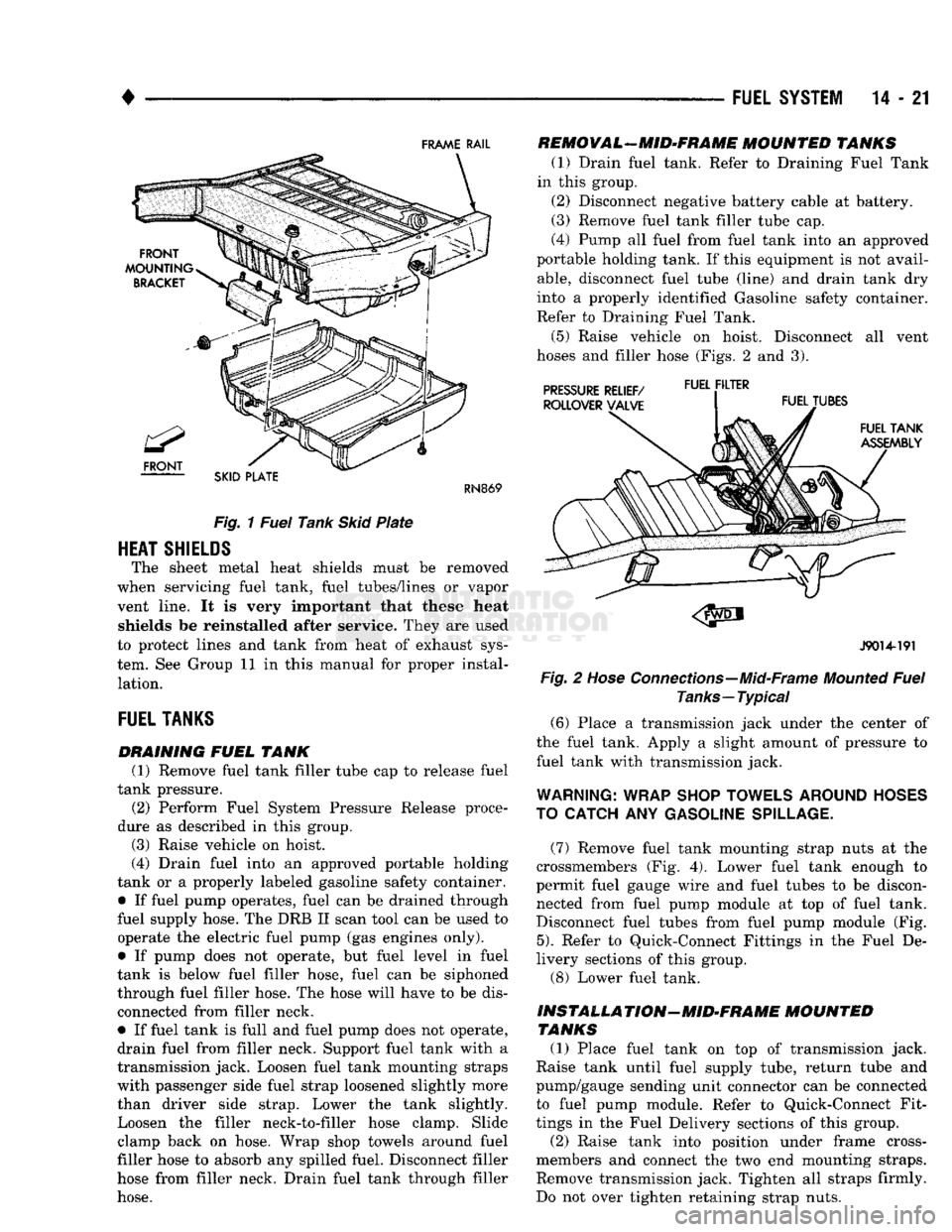
•
FUEL
SYSTEM
14-21
FRAME
RAIL
SKID
PLATE
RN869
Fig.
1
Fuel
Tank
Skid
Plate
HEAT
SHIELDS
The sheet metal heat shields must be removed
when servicing fuel tank, fuel tubes/lines or vapor
vent line. It is very important that these heat shields be reinstalled after service. They are used
to protect lines and tank from heat of exhaust sys
tem. See Group 11 in this manual for proper instal lation.
FUEL
TANKS
DRAINING
FUEL
TANK
(1) Remove fuel tank filler tube cap to release fuel
tank pressure. (2) Perform Fuel System Pressure Release proce
dure as described in this group.
(3) Raise vehicle on hoist.
(4) Drain fuel into an approved portable holding
tank or a properly labeled gasoline safety container.
• If fuel pump operates, fuel can be drained through
fuel supply hose. The DRB II scan tool can be used to operate the electric fuel pump (gas engines only).
• If pump does not operate, but fuel level in fuel
tank is below fuel filler hose, fuel can be siphoned
through fuel filler hose. The hose will have to be dis connected from filler neck.
• If fuel tank is full and fuel pump does not operate,
drain fuel from filler neck. Support fuel tank with a
transmission jack. Loosen fuel tank mounting straps with passenger side fuel strap loosened slightly more
than driver side strap. Lower the tank slightly. Loosen the filler neck-to-filler hose clamp. Slide
clamp back on hose. Wrap shop towels around fuel
filler hose to absorb any spilled fuel. Disconnect filler
hose from filler neck. Drain fuel tank through filler
hose.
REMOVAL-MID-FRAME
MOUNTED
TANKS
(1) Drain fuel tank. Refer to Draining Fuel Tank
in this group. (2) Disconnect negative battery cable at battery.
(3) Remove fuel tank filler tube cap.
(4) Pump all fuel from fuel tank into an approved
portable holding tank. If this equipment is not avail
able,
disconnect fuel tube (line) and drain tank dry
into a properly identified Gasoline safety container.
Refer to Draining Fuel Tank.
(5) Raise vehicle on hoist. Disconnect all vent
hoses and filler hose (Figs. 2 and 3).
PRESSURE
RELIEF/
FUEL F,LTER
J9014-191
Fig.
2
Hose
Connections—Mid-Frame
Mounted
Fuel
Tanks—Typical (6) Place a transmission jack under the center of
the fuel tank. Apply a slight amount of pressure to fuel tank with transmission jack.
WARNING:
WRAP
SHOP
TOWELS
AROUND
HOSES
TO
CATCH
ANY
GASOLINE
SPILLAGE.
(7) Remove fuel tank mounting strap nuts at the
crossmembers (Fig. 4). Lower fuel tank enough to
permit fuel gauge wire and fuel tubes to be discon nected from fuel pump module at top of fuel tank.
Disconnect fuel tubes from fuel pump module (Fig.
5).
Refer to Quick-Connect Fittings in the Fuel De
livery sections of this group.
(8) Lower fuel tank.
INSTALLA
TION—MID-FRAME
MOUNTED
TANKS (1) Place fuel tank on top of transmission jack.
Raise tank until fuel supply tube, return tube and
pump/gauge sending unit connector can be connected to fuel pump module. Refer to Quick-Connect Fit
tings in the Fuel Delivery sections of this group.
(2) Raise tank into position under frame cross-
members and connect the two end mounting straps.
Remove transmission jack. Tighten all straps firmly.
Do not over tighten retaining strap nuts.
Page 841 of 1502
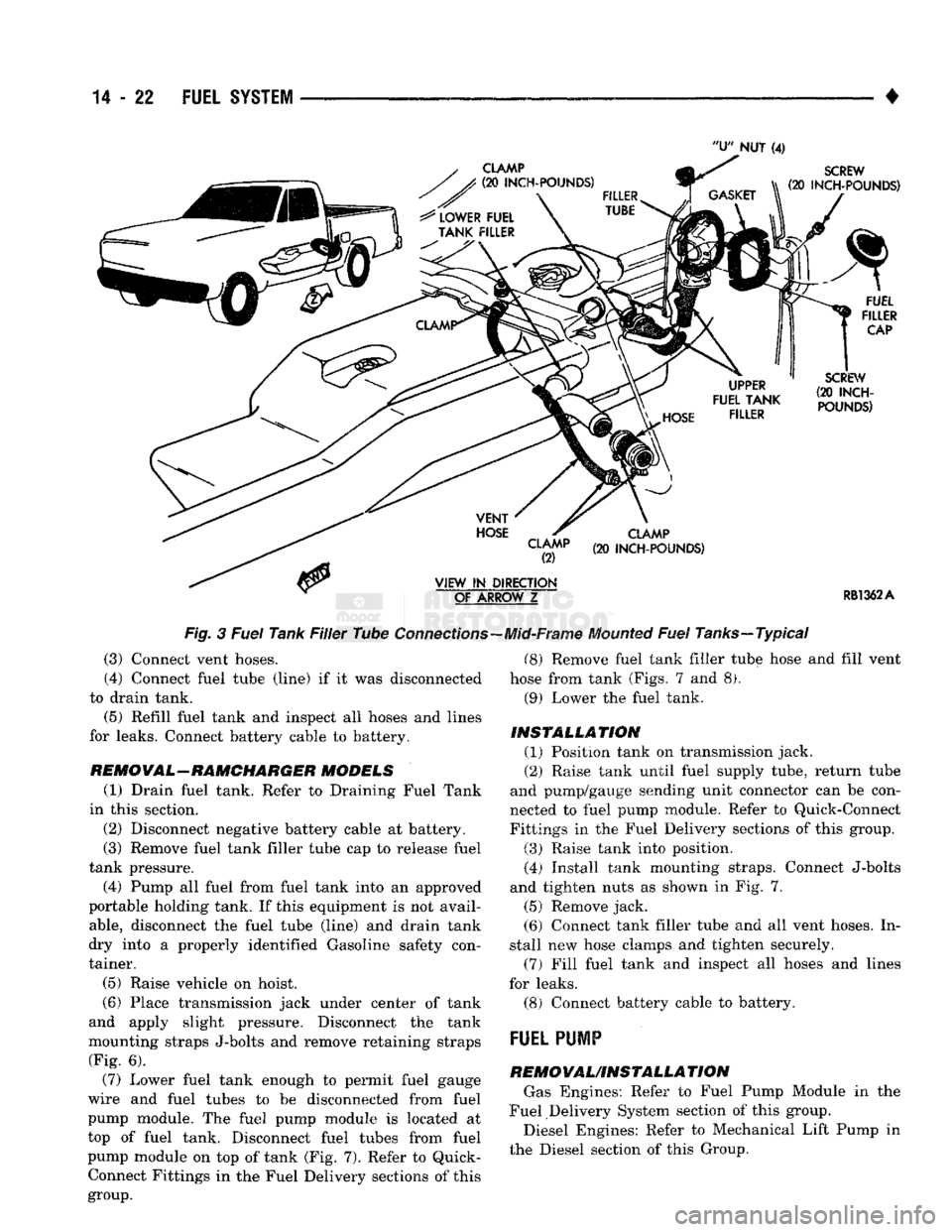
14
- 22
FUEL SYSTEM
•
CLAMP (2)
VIEW
IN
DIRECTION OF
ARROW
Z
CLAMP
(20
INCH-POUNDS)
RB1362A
Fig. 3 Fuel Tank Filler Tube
Connections-
(3) Connect vent hoses.
(4) Connect fuel tube (line) if it was disconnected
to drain tank. (5) Refill fuel tank and inspect all hoses and lines
for leaks. Connect battery cable to battery.
RE MO VA L—RAMCHARGER MODELS (1) Drain fuel tank. Refer to Draining Fuel Tank
in this section. (2) Disconnect negative battery cable at battery.
(3) Remove fuel tank filler tube cap to release fuel
tank pressure. (4) Pump all fuel from fuel tank into an approved
portable holding tank. If this equipment is not avail
able,
disconnect the fuel tube (line) and drain tank
dry into a properly identified Gasoline safety con
tainer.
(5) Raise vehicle on hoist.
(6) Place transmission jack under center of tank
and apply slight pressure. Disconnect the tank
mounting straps J-bolts and remove retaining straps (Fig. 6).
(7) Lower fuel tank enough to permit fuel gauge
wire and fuel tubes to be disconnected from fuel
pump module. The fuel pump module is located at
top of fuel tank. Disconnect fuel tubes from fuel
pump module on top of tank (Fig. 7). Refer to Quick- Connect Fittings in the Fuel Delivery sections of this
group. -Mid-Frame
Mounted
Fuel
Tanks—Typical
(8) Remove fuel tank filler tube hose and fill vent
hose from tank (Figs. 7 and 8). (9) Lower the fuel tank.
INSTALLATION (1) Position tank on transmission jack.
(2) Raise tank until fuel supply tube, return tube
and pump/gauge sending unit connector can be con
nected to fuel pump module. Refer to Quick-Connect Fittings in the Fuel Delivery sections of this group.
(3) Raise tank into position. (4) Install tank mounting straps. Connect J-bolts
and tighten nuts as shown in Fig. 7.
(5) Remove jack. (6) Connect tank filler tube and all vent hoses. In
stall new hose clamps and tighten securely. (7) Fill fuel tank and inspect all hoses and lines
for leaks. (8) Connect battery cable to battery.
FUEL PUMP
REMOVAL/INSTALLA TION Gas Engines: Refer to Fuel Pump Module in the
Fuel Delivery System section of this group. Diesel Engines: Refer to Mechanical Lift Pump in
the Diesel section of this Group.
Page 860 of 1502
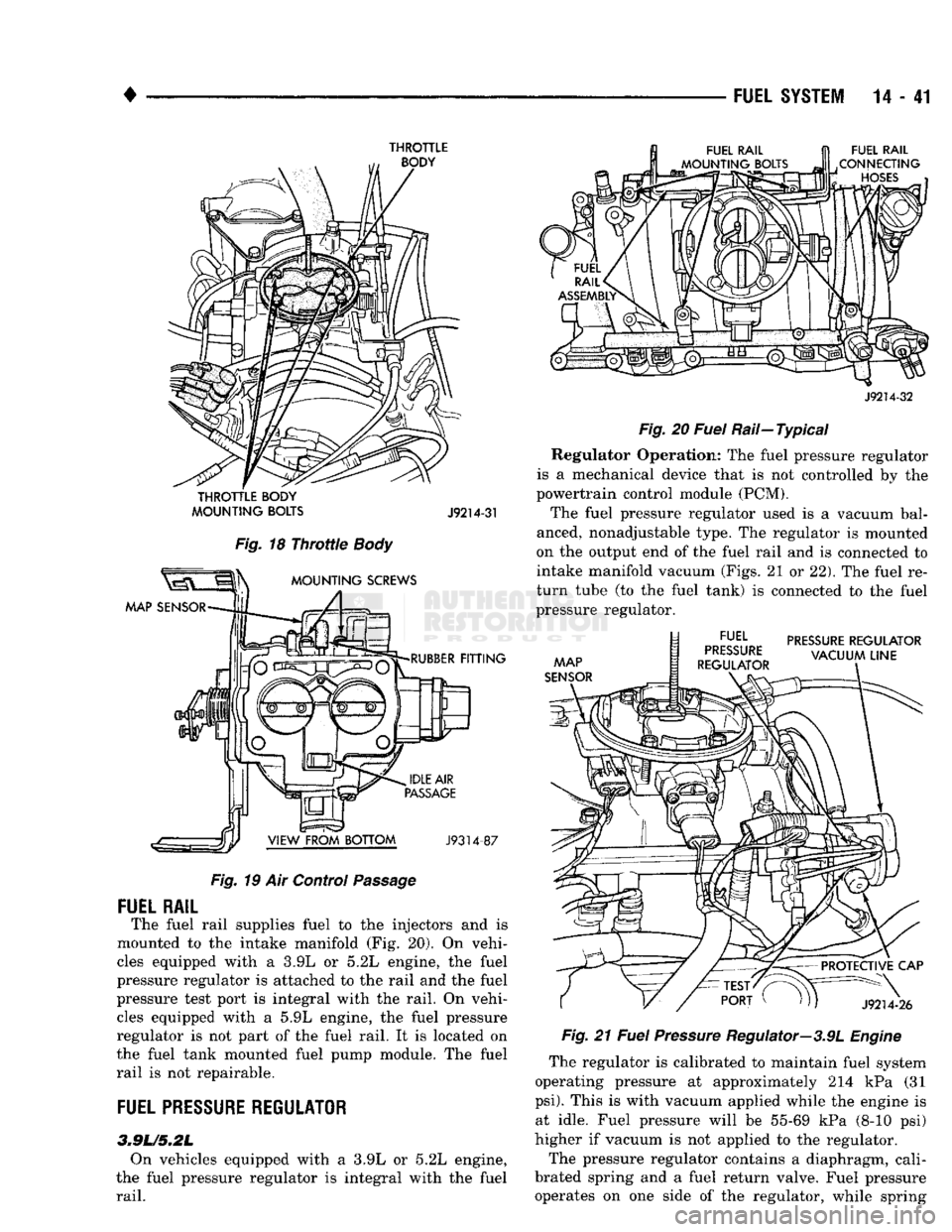
•
FUEL
SYSTEM
14 - 41
THROTTLE
BODY
FUEL
RAIL
CONNECTING
HOSES
THROTTLE
BODY
MOUNTING
BOLTS
J9214-31
Fig.
18
Throttle
Body
MOUNTING
SCREWS
MAP
SENSOR
RUBBER
FITTING
J9314-87
Fig.
19 Air Control
Passage
FUEL
RAIL
The fuel rail supplies fuel to the injectors and is
mounted to the intake manifold (Fig. 20). On vehi
cles equipped with a 3.9L or 5.2L engine, the fuel
pressure regulator is attached to the rail and the fuel
pressure test port is integral with the rail. On vehi cles equipped with a 5.9L engine, the fuel pressure
regulator is not part of the fuel rail. It is located on
the fuel tank mounted fuel pump module. The fuel
rail is not repairable.
FUEL
PRESSURE
REGULATOR
3.9L/5.2L On vehicles equipped with a 3.9L or 5.2L engine,
the fuel pressure regulator is integral with the fuel
rail.
J9214-32
Fig.
20
Fuel
Rail—Typical Regulator Operation: The fuel pressure regulator
is a mechanical device that is not controlled by the
powertrain control module (PCM).
The fuel pressure regulator used is a vacuum bal
anced, nonadjustable type. The regulator is mounted
on the output end of the fuel rail and is connected to
intake manifold vacuum (Figs. 21 or 22). The fuel re
turn tube (to the fuel tank) is connected to the fuel
pressure regulator.
MAP
SENSOR
docc EL
PRESSURE
REGULATOR
„
VACUUM
LINE
REGULATOR
PROTECTIVE
CAP
J9214-26
Fig.
21
Fuel
Pressure
Regulator—3.9L
Engine
The regulator is calibrated to maintain fuel system
operating pressure at approximately 214 kPa (31
psi).
This is with vacuum applied while the engine is at idle. Fuel pressure will be 55-69 kPa (8-10 psi)
higher if vacuum is not applied to the regulator.
The pressure regulator contains a diaphragm, cali
brated spring and a fuel return valve. Fuel pressure operates on one side of the regulator, while spring
Page 861 of 1502
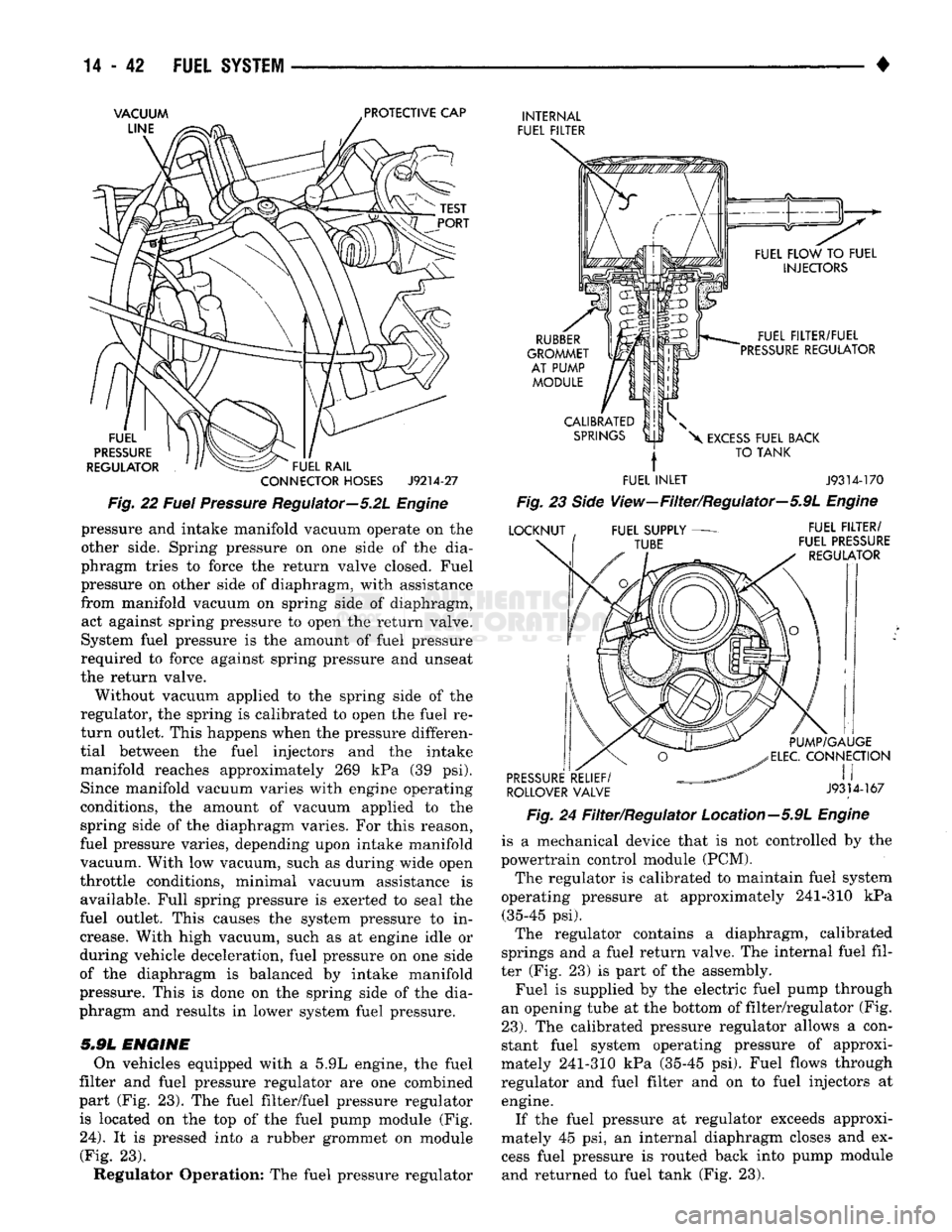
VACUUM
LINE
PROTECTIVE
CAP
INTERNAL
FUEL FILTER FUEL
PRESSURE
REGULATOR FUEL RAIL
CONNECTOR
HOSES
J9214-27
Fig.
22
Fuel
Pressure
Regulator—5.2L
Engine
pressure
and
intake manifold vacuum operate
on the
other side. Spring pressure
on one
side
of the
dia
phragm tries
to
force
the
return valve closed. Fuel
pressure
on
other side
of
diaphragm, with assistance from manifold vacuum
on
spring side
of
diaphragm, act against spring pressure
to
open
the
return valve.
System fuel pressure
is the
amount
of
fuel pressure
required
to
force against spring pressure
and
unseat
the return valve.
Without vacuum applied
to the
spring side
of the
regulator,
the
spring
is
calibrated
to
open
the
fuel
re
turn outlet. This happens when
the
pressure differen
tial between
the
fuel injectors
and the
intake
manifold reaches approximately
269 kPa (39 psi).
Since manifold vacuum varies with engine operating
conditions,
the
amount
of
vacuum applied
to the
spring side
of the
diaphragm varies.
For
this reason,
fuel pressure varies, depending upon intake manifold
vacuum. With
low
vacuum, such
as
during wide open
throttle conditions, minimal vacuum assistance
is
available. Full spring pressure
is
exerted
to
seal
the
fuel outlet. This causes
the
system pressure
to in
crease. With high vacuum, such
as at
engine idle
or
during vehicle deceleration, fuel pressure
on one
side
of
the
diaphragm
is
balanced
by
intake manifold
pressure. This
is
done
on the
spring side
of the
dia
phragm
and
results
in
lower system fuel pressure.
5.9L
ENGINE
On vehicles equipped with
a 5.9L
engine,
the
fuel
filter and fuel pressure regulator
are one
combined
part
(Fig. 23). The
fuel filter/fuel pressure regulator is located
on the top of the
fuel pump module
(Fig.
24).
It is
pressed into
a
rubber grommet
on
module (Fig.
23).
Regulator Operation:
The
fuel pressure regulator
RUBBER
GROMMET AT PUMP MODULE FUEL FILTER/FUEL
PRESSURE REGULATOR
CALIBRATED SPRINGS
X
EXCESS FUEL BACK
TO TANK
FUEL INLET J9314-170
Fig.
23
Side
View—Filter/Regulator—5.9L
Engine
LOCKNUT FUEL SUPPLY
TUBE FUEL FILTER/
FUEL PRESSURE REGULATOR PUMP/GAUGE
ELEC.
CONNECTION
PRESSURE RELIEF/
, I I
ROLLOVER VALVE
J9314-167
Fig.
24
Filter/Regulator Location—5.9L
Engine
is
a
mechanical device that
is not
controlled
by the
powertrain control module (PCM).
The regulator
is
calibrated
to
maintain fuel system
operating pressure
at
approximately 241-310
kPa
(35-45
psi).
The regulator contains
a
diaphragm, calibrated
springs
and a
fuel return valve.
The
internal fuel fil
ter
(Fig. 23) is
part
of the
assembly. Fuel
is
supplied
by the
electric fuel pump through
an opening tube
at the
bottom
of
filter/regulator
(Fig.
23).
The
calibrated pressure regulator allows
a
con
stant fuel system operating pressure
of
approxi
mately 241-310
kPa
(35-45
psi).
Fuel flows through
regulator
and
fuel filter
and on to
fuel injectors
at
engine. If
the
fuel pressure
at
regulator exceeds approxi
mately
45 psi, an
internal diaphragm closes
and ex
cess fuel pressure
is
routed back into pump module and returned
to
fuel tank
(Fig. 23).
Page 863 of 1502

14 - 44
FUEL
SYSTEM
•
Fig.
4 ignition Coil—5.9L
HDC-Gas
Engine
(5) Verify that distributor cap is correctly attached
to distributor. Be sure that spark plug cables are
firmly connected to the distributor cap and the spark
plugs are in their correct firing order. Be sure that coil cable is firmly connected to distributor cap and
coil. Be sure that camshaft position sensor wire con
nector (at the distributor) is firmly connected to har
ness connector. Inspect spark plug condition. Refer to Group 8D, Ignition. Connect vehicle to an oscillo
scope and inspect spark events for fouled or damaged
spark plugs or cables.
(6) Verify that generator output wire, generator
connector and ground wire are firmly connected to
the generator. (7) Inspect the system body grounds for loose or
dirty connections. Refer to Group 8, Wiring for
ground locations. (8) Verify positive crankcase ventilation (PCV)
valve operation. Refer to Group 25, Emission Control System for additional information. Verify PCV valve
hose is firmly connected to PCV valve and manifold (Fig. 5).
Fig.
5 PCV
Valve
Hose
Connections—Typical (9) On 3.9L and 5.2L engines, verify that vacuum
hose is firmly connected to fuel pressure regulator and manifold fitting (Figs. 6 or 7).
CONNECTOR
HOSES
J9214-27
Fig.
7
Pressure
Regulator
Vacuum
Hose—5.2L
Engine
(10) Inspect fuel* tube quick-connect fitting-to-fuel
rail connections. (11) Verify that hose connections to all ports of
vacuum fittings on intake manifold are tight and not leaking.
Page 877 of 1502
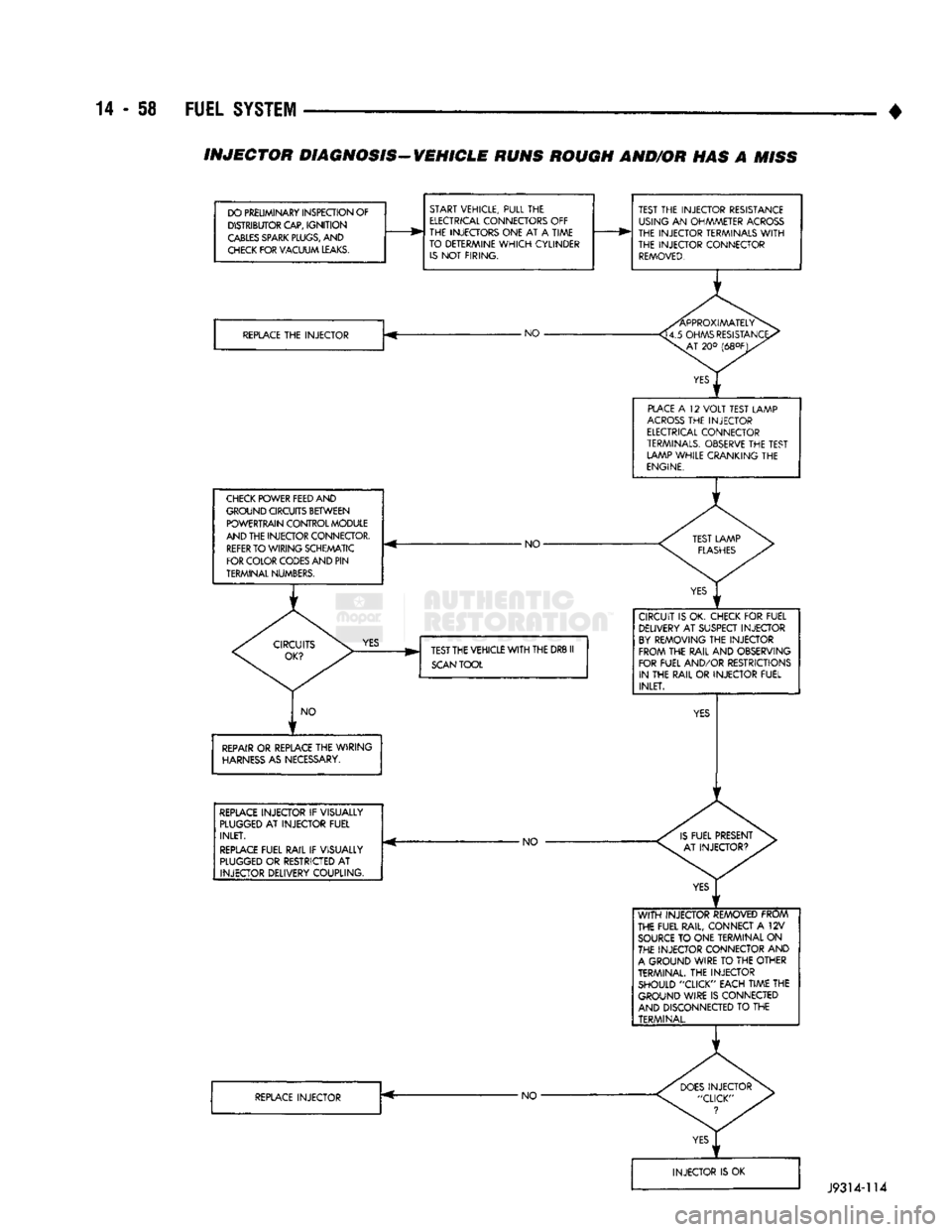
14 - 58
FUEL
SYSTEM
• INJECTOR DIAGNOSIS-VEHICLE RUNS ROUGH AND/OR HAS A
MISS
DO PRELIMINARY INSPECTION OF DISTRIBUTOR CAP,
IGNITION
CABLES
SPARK
PLUGS,
AND
CHECK
FOR VACUUM
LEAKS.
START VEHICLE, PULL THE
ELECTRICAL
CONNECTORS OFF
THE INJECTORS ONE AT A TIME
TO DETERMINE
WHICH
CYLINDER
IS
NOT FIRING.
REPLACE
THE INJECTOR -NO •
CHECK
POWER FEED AND
GROUND CIRCUITS BETWEEN POWERTRAIN CONTROL MODULE
AND THE INJECTOR CONNECTOR.
REFER
TO WIRING SCHEMATIC
FOR COLOR CODES AND PIN
TERMINAL NUMBERS. - NO-
YES
TEST THE VEHICLE
WITH
THE DRB II
SCAN
TOOL
NO
REPAIR
OR REPLACE THE WIRING
HARNESS
AS NECESSARY.
REPLACE
INJECTOR IF VISUALLY
PLUGGED
AT INJECTOR FUEL INLET.
REPLACE
FUEL RAIL IF VISUALLY
PLUGGED
OR RESTRICTED AT INJECTOR DELIVERY COUPLING. -NO
REPLACE
INJECTOR •NO-TEST THE INJECTOR RESISTANCE
USING AN OHMMETER
ACROSS
THE INJECTOR TERMINALS
WITH
THE INJECTOR CONNECTOR
REMOVED.
PLACE
A 12
VOLT
TEST LAMP
ACROSS
THE INJECTOR
ELECTRICAL
CONNECTOR
TERMINALS.
OBSERVE THE TEST LAMP WHILE CRANKING THE
ENGINE.
CIRCUIT IS OK. CHECK FOR FUEL DELIVERY AT SUSPECT INJECTOR
BY
REMOVING THE INJECTOR FROM THE RAIL AND OBSERVING
FOR FUEL AND/OR RESTRICTIONS IN THE RAIL OR INJECTOR FUEL INLET.
WITH
INJECTOR REMOVED FROM
THE FUEL RAIL, CONNECT A 12V
SOURCE
TO ONE TERMINAL ON
THE INJECTOR CONNECTOR AND
A
GROUND WIRE TO THE OTHER
TERMINAL. THE INJECTOR SHOULD "CLICK" EACH TIME THE GROUND WIRE IS CONNECTED
AND DISCONNECTED TO THE TERMINAL.
J9314-114
Page 887 of 1502
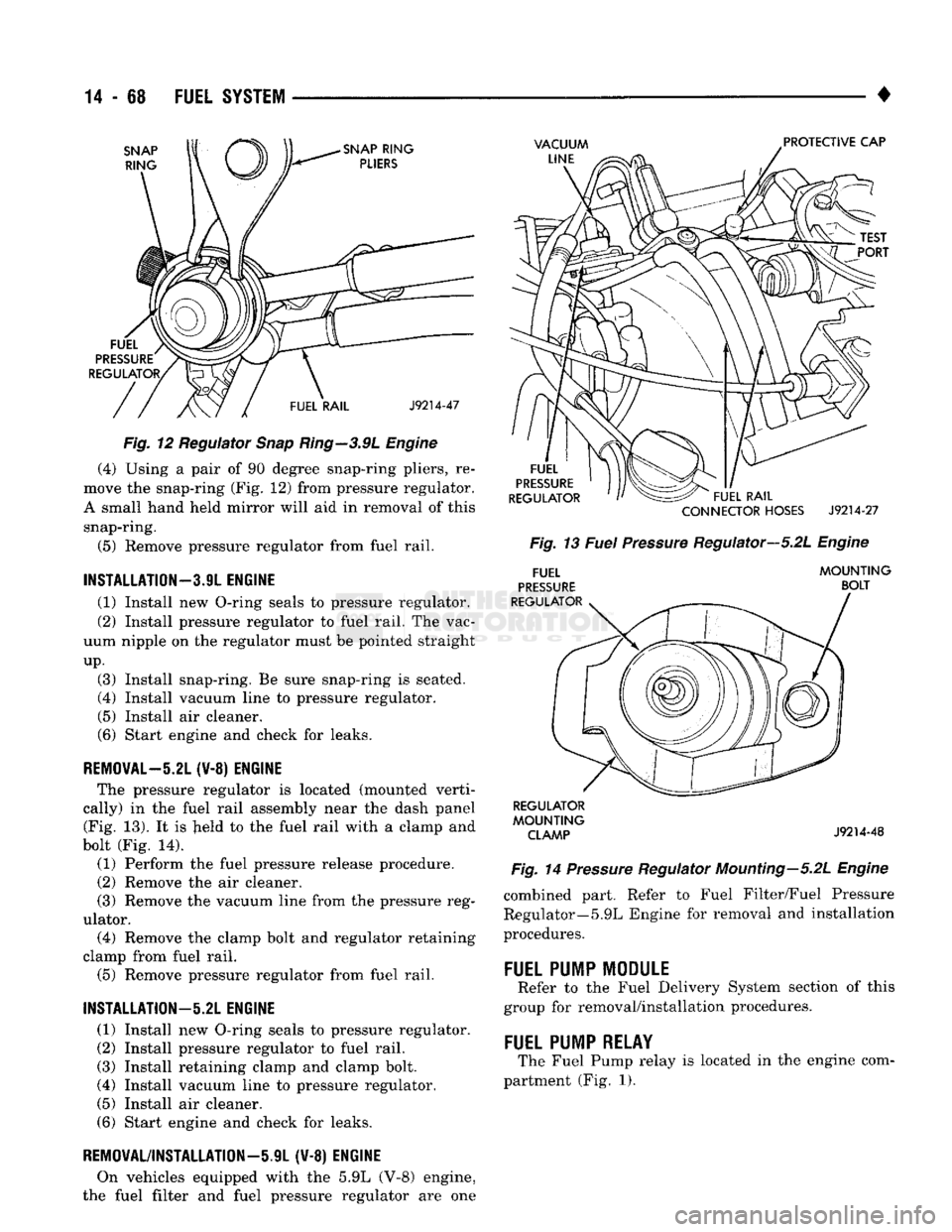
14
- 68
FUEL
SYSTEM
•
SNAP
RING
SNAP
RING
PLIERS
VACUUM
LINE
PROTECTIVE CAP
FUEL
PRESSURE
REGULATOR,
FUEL RAIL
J9214-47
Fig. 12 Regulator Snap Ring—3.9L Engine (4) Using a pair of 90 degree snap-ring pliers, re
move the snap-ring (Fig. 12) from pressure regulator.
A small hand held mirror will aid in removal of this snap-ring.
(5) Remove pressure regulator from fuel rail.
INSTALLATION—3.9L
ENGINE
(1) Install new O-ring seals to pressure regulator.
(2) Install pressure regulator to fuel rail. The vac
uum nipple on the regulator must be pointed straight
up.
(3) Install snap-ring. Be sure snap-ring is seated.
(4) Install vacuum line to pressure regulator.
(5) Install air cleaner.
(6) Start engine and check for leaks.
REMOVAL-5.21
(¥-8) ENGINE The pressure regulator is located (mounted verti
cally) in the fuel rail assembly near the dash panel (Fig. 13). It is Jield to the fuel rail with a clamp and
bolt (Fig. 14).
(1) Perform the fuel pressure release procedure.
(2) Remove the air cleaner.
(3) Remove the vacuum line from the pressure reg
ulator. (4) Remove the clamp bolt and regulator retaining
clamp from fuel rail.
(5) Remove pressure regulator from fuel rail.
INSTALLATION—5.2L
ENGINE
(1) Install new O-ring seals to pressure regulator.
(2) Install pressure regulator to fuel rail. (3) Install retaining clamp and clamp bolt.
(4) Install vacuum line to pressure regulator.
(5) Install air cleaner.
(6) Start engine and check for leaks.
REMOVAL/INSTALLATION—iJL (V-8) ENGINE
On vehicles equipped with the 5.9L (V-8) engine,
the fuel filter and fuel pressure regulator are one
FUEL
PRESSURE
REGULATOR FUEL RAIL
CONNECTOR
HOSES
J9214-27
Fig. 13 Fuel Pressure Regulator—5.2L Engine
FUEL
PRESSURE
REGULATOR MOUNTING
BOLT REGULATOR
MOUNTING CLAMP
J9214-48
Fig. 14 Pressure Regulator Mounting—5.2L Engine combined part. Refer to Fuel Filter/Fuel Pressure
Regulator—5.9L Engine for removal and installation
procedures.
FUEL
PUMP
MODULE
Refer to the Fuel Delivery System section of this
group for removal/installation procedures.
FUEL
PUMP
RELAY
The Fuel Pump relay is located in the engine com
partment (Fig. 1).
Page 912 of 1502
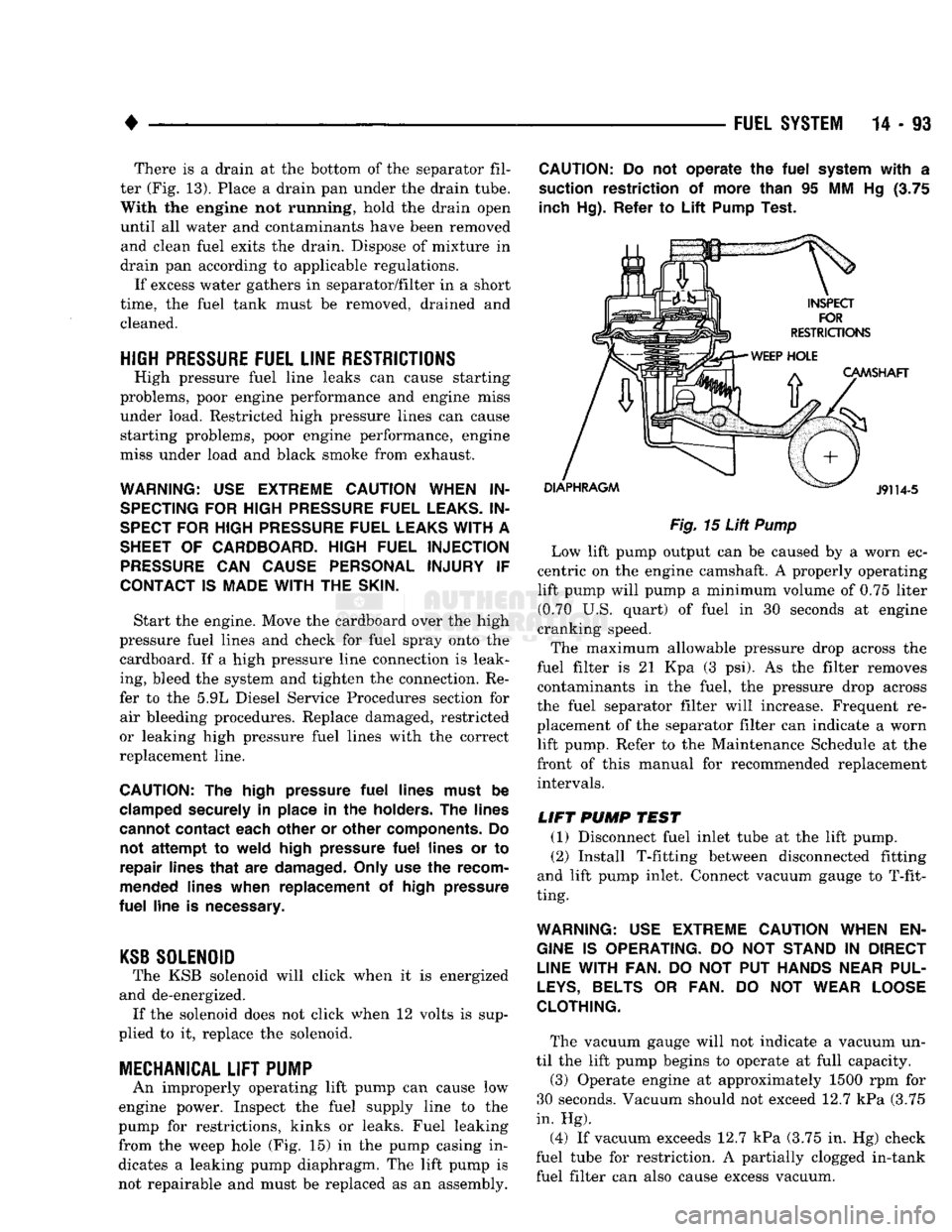
•
FUEL SYSTEM
14-93 There is a drain at the bottom of the separator fil
ter (Fig. 13). Place a drain pan under the drain tube. With the engine not running, hold the drain open
until all water and contaminants have been removed and clean fuel exits the drain. Dispose of mixture in
drain pan according to applicable regulations.
If excess water gathers in separator/filter in a short
time,
the fuel tank must be removed, drained and cleaned.
HIGH
PRESSURE FUEL LINE RESTRICTIONS
High pressure fuel line leaks can cause starting
problems, poor engine performance and engine miss under load. Restricted high pressure lines can cause starting problems, poor engine performance, engine
miss under load and black smoke from exhaust.
WARNING:
USE
EXTREME
CAUTION
WHEN
IN
SPECTING
FOR HIGH
PRESSURE
FUEL
LEAKS.
IN
SPECT
FOR HIGH
PRESSURE
FUEL
LEAKS
WITH
A
SHEET
OF
CARDBOARD.
HIGH
FUEL
INJECTION
PRESSURE
CAN
CAUSE
PERSONAL
INJURY
IF
CONTACT
IS
MADE
WITH
THE
SKIN.
Start the engine. Move the cardboard over the high
pressure fuel lines and check for fuel spray onto the cardboard. If a high pressure line connection is leak
ing, bleed the system and tighten the connection. Re
fer to the 5.9L Diesel Service Procedures section for air bleeding procedures. Replace damaged, restricted
or leaking high pressure fuel lines with the correct replacement line.
CAUTION:
The
high pressure
fuel
lines must
be
clamped securely
in
place
in the
holders.
The
lines cannot contact each other
or
other components.
Do
not
attempt
to
weld high pressure
fuel
lines
or to
repair lines
that
are
damaged. Only
use the
recom
mended lines when replacement
of
high pressure
fuel
line
is
necessary.
KSB
SOLENOID
The KSB solenoid will click when it is energized
and de-energized. If the solenoid does not click when 12 volts is sup
plied to it, replace the solenoid.
MECHANICAL
LIFT
PUMP
An improperly operating lift pump can cause low
engine power. Inspect the fuel supply line to the
pump for restrictions, kinks or leaks. Fuel leaking
from the weep hole (Fig. 15) in the pump casing in
dicates a leaking pump diaphragm. The lift pump is not repairable and must be replaced as an assembly.
CAUTION:
Do not
operate
the
fuel
system
with
a
suction restriction
of
more than
95 MM Hg (3.75
inch Hg). Refer
to
Lift
Pump Test.
Fig.
15
Lift
Pump
Low lift pump output can be caused by a worn ec
centric on the engine camshaft. A properly operating lift pump will pump a minimum volume of 0.75 liter (0.70 U.S. quart) of fuel in 30 seconds at engine
cranking speed.
The maximum allowable pressure drop across the
fuel filter is 21 Kpa (3 psi). As the filter removes contaminants in the fuel, the pressure drop across
the fuel separator filter will increase. Frequent re
placement of the separator filter can indicate a worn lift pump. Refer to the Maintenance Schedule at the
front of this manual for recommended replacement intervals.
LIFT
PUMP
TEST
(1) Disconnect fuel inlet tube at the lift pump. (2) Install T-fitting between disconnected fitting
and lift pump inlet. Connect vacuum gauge to T-fit
ting.
WARNING:
USE
EXTREME
CAUTION
WHEN
EN
GINE
IS
OPERATING.
DO NOT
STAND
IN
DIRECT
LINE
WITH FAN.
DO NOT PUT
HANDS
NEAR
PUL
LEYS,
BELTS
OR FAN. DO NOT
WEAR
LOOSE
CLOTHING.
The vacuum gauge will not indicate a vacuum un
til the lift pump begins to operate at full capacity.
(3) Operate engine at approximately 1500 rpm for
30 seconds. Vacuum should not exceed 12.7 kPa (3.75
in. Hg).
(4) If vacuum exceeds 12.7 kPa (3.75 in. Hg) check
fuel tube for restriction. A partially clogged in-tank fuel filter can also cause excess vacuum.